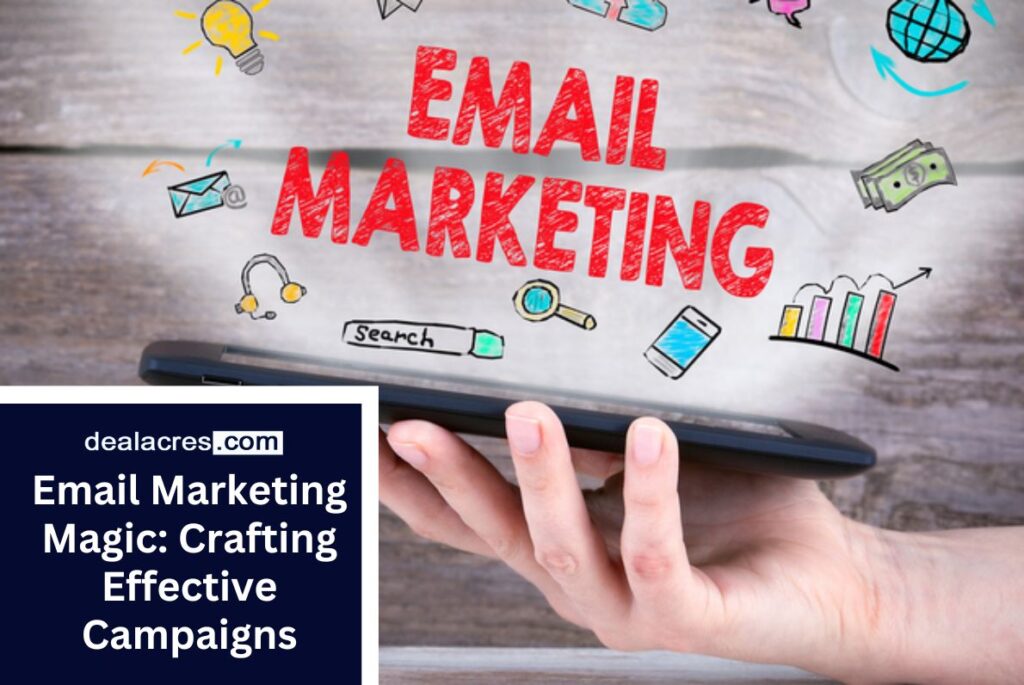In the fast-paced world of digital communication, email marketing remains a powerful tool for businesses to connect with their audience. Crafting effective email campaigns involves more than just hitting the send button; it requires a strategic approach to capture attention, engage readers, and drive desired actions. In this comprehensive guide, we’ll explore the magic behind successful email marketing campaigns, breaking down the essential elements that make emails stand out in crowded inboxes.
Understanding the Power of Email Marketing

1. Personal Connection:
Email allows businesses to establish a direct and personalized connection with their audience.
Customizing messages based on user preferences enhances engagement.
2. Cost-Effective:
Email marketing is cost-effective compared to traditional advertising.
It provides an excellent return on investment (ROI) when executed strategically.
3. Targeted Messaging:
Segmentation allows businesses to send targeted messages to specific audience segments.
Tailoring content based on demographics, behaviour, or preferences increases relevance.
4. Measurable Results:
Email marketing platforms provide detailed analytics.
Metrics such as open rates, click-through rates, and conversions offer insights for improvement.
Crafting Compelling Email Campaigns
1. Building a Quality Email List:
Permission-Based: Ensure subscribers opt-in to receive emails.
Segmentation: Organize the list based on demographics, behaviours, or purchase history.
Clean and Update: Regularly clean the list to remove inactive or unsubscribed users.
2. Creating Attention-Grabbing Subject Lines:
Personalization: Include the recipient’s name for a personalized touch.
Urgency or Curiosity: Use language that sparks curiosity or conveys urgency.
Clarity: Clearly communicate the email’s value or content.
3. Engaging Email Content:
Clear Call-to-Action (CTA): Clearly instruct readers on the desired action.
Visual Appeal: Use images, videos, and a well-designed layout.
Relevant and Valuable Content: Provide content that addresses the audience’s needs or interests.

4. Mobile Optimization:
Responsive Design: Ensure emails are mobile-friendly.
Concise Content: Optimize content for quick mobile consumption.
5. A/B Testing:
Subject Lines: Test different subject lines to identify what resonates best.
CTA Buttons: Experiment with variations to boost click-through rates.
6. Personalization:
Dynamic Content: Tailor content based on user preferences or behaviour.
Behavioural Triggers: Set up automated responses based on user actions.
7. Timing and Frequency:
Optimal Timing: Determine the times when your audience is most likely to engage.
Consistency: Maintain a consistent sending schedule without overwhelming subscribers.
8. Social Media Integration:
Shareable Content: Include social media sharing buttons.
Cross-Promotion: Integrate email campaigns with social media strategies.
9. Compliance with Regulations:
GDPR and CAN-SPAM Compliance: Adhere to data protection regulations.
Clear Unsubscribe Option: Make it easy for users to opt-out.
10. Analytics and Iteration:
Track Key Metrics: Monitor open rates, click-through rates, and conversion metrics.
Iterate Based on Data: Use analytics to refine future campaigns.
Types of Email Campaigns
1. Welcome Emails:
Introduce new subscribers to your brand.
Set expectations for future communication.
2. Promotional Emails:
Highlight special offers, discounts, or promotions.
Create a sense of urgency to drive immediate action.
3. Educational Content:
Share valuable content, tutorials, or industry insights.
Position your brand as an authority in your niche.
4. Abandoned Cart Emails:
Remind users about items left in their shopping cart.
Include incentives or discounts to encourage completion.
5. Survey or Feedback Requests:
Gather feedback from customers to improve products or services.
Offer incentives for completing surveys.
6. Event Invitations:
Promote webinars, product launches, or in-person events.
Include compelling visuals and a clear CTA.
7. Newsletter Updates:
Keep subscribers informed about company news and updates.
Curate relevant content to maintain engagement.
Nurturing Customer Relationships
1. Personalized Recommendations:
Use data to recommend products or services based on past interactions.
Showcase related items or complementary products.
2. Anniversary or Milestone Emails:
Celebrate customer anniversaries or milestones.
Offer exclusive discounts or rewards as a token of appreciation.
3. Exclusive VIP Offers:
Create a VIP or loyalty program for special customers.
Provide exclusive offers, sneak peeks, or early access.

4. Re-Engagement Campaigns:
Identify inactive subscribers and re-engage them.
Offer incentives or exclusive content to encourage reactivation.
Email Marketing Trends
1. Interactive Emails:
Incorporate interactive elements like quizzes, polls, or surveys.
Encourage users to engage directly within the email.
2. AI-Powered Personalization:
Use artificial intelligence to analyze user behaviour.
Deliver highly personalized content and recommendations.
3. User-Generated Content:
Showcase content created by customers.
Encourage users to share their experiences.
4. Minimalist Design:
Opt for clean and minimalist email designs.
Focus on clarity and a straightforward user experience.
5. Dark Mode Compatibility:
Ensure emails are optimized for dark mode.
Consider offering a dark mode toggle in emails.
Overcoming Common Challenges
1. Deliverability Issues:
Maintain a clean email list to avoid being marked as spam.
Use a reputable email service provider.
2. Low Open Rates:
Experiment with different subject lines.
Segment your audience for more targeted messaging.
3. High Unsubscribe Rates:
Set clear expectations during the opt-in process.
Provide valuable and relevant content to keep subscribers engaged.
4. Adapting to Change:
Stay informed about email marketing trends and best practices.
Be flexible and adapt strategies based on evolving consumer behaviours.
Conclusion
Email marketing, when executed with thoughtfulness and strategy, has the power to build lasting relationships, drive sales, and enhance brand loyalty. By understanding the core elements of effective email campaigns, embracing emerging trends, and continually refining your approach based on analytics, you can unlock the magic of email marketing. Remember, the key lies not just in sending emails but in creating meaningful connections that resonate with your audience and make your brand unforgettable in the crowded digital landscape.




